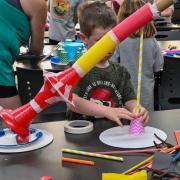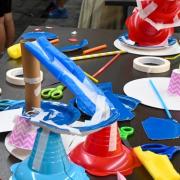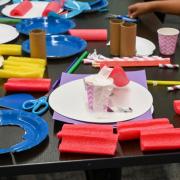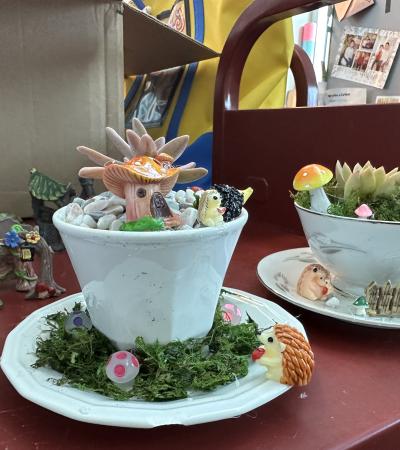This school-age children’s STEAM crafting program is part of the weekly “Make It Monday” summer reading programming series held annually from June to August 1st. Caregivers attend the hour-long event with their children. For this particular event, participants were given limited supplies and challenged to create a miniature rollercoaster maze for their wooden ball to travel through.
Advanced Planning
Our goal for this program was to encourage problem-solving and creativity by challenging participants to construct a maze using a limited amount of materials. For a fun twist, we asked them to imagine their maze as an amusement park ride. We planned the program six weeks in advance.
The challenges we faced were deciding on a theme to add a twist to maze-making projects and then choosing what materials to provide and in what quantity.
Marketing
This program was featured as part of the Summer Reading Program's 'Make It Monday' craft series. It was promoted through the library's event page and included in the marketing materials for the 2024 Summer Reading Program.
Budgeting
For this program, we “swept the supply room,” using leftover materials from previous activities, including paper plates, cups, straws, sections of pool noodles, wood balls, snow cone cups, chopsticks, pipe cleaners and construction paper. We allocated funds to purchase 10” cake boards as the base for the mazes along with 24 rolls of 1/2” masking tape.
Ways to control costs for this program:
• Use recycled cardboard as the base for the mazes
• Limit the number of participants in the program
Day-of-event Activity
We used PowerPoint slides to showcase examples from Pinterest of how the materials could be used to help inspire ideas. We then presented a slide listing the supplies available for each build.
A materials table was set up for participants to collect their supplies. Our room was arranged with four long rows of tables, allowing ample workspace for children to spread out but also encouraging collaboration.
Two staff members facilitated the program and were responsible for set up and tear down.
Program Execution
The event was attended by 64 people, including 40 children. At the beginning of the program, we explained the goal of the project and showed a PowerPoint slide with some examples of mazes, including mazes built within the theme of a rollercoaster. We purposely chose not to create a sample as we wanted to encourage open-ended creativity and allow participants to explore their own ideas without preconceived limitations.
We then discussed the list and showed the supplies they could use. Finally, we offered them a challenge to build their own rollercoaster or any other type of amusement park ride.
Once children returned to their tables with their supplies, staff walked around offering encouragement and prompts to spark new ideas.
Towards the end of the program, children were encouraged to create a name for their ride and demonstrate how it worked, with questions and answers on how to refine their design by adding more tape, changing an angle, etc.
What stood out was the deep and meaningful engagement among the children. They spontaneously collaborated, sharing materials and working together to create larger, more intricate projects. Adult caregivers were actively involved, offering support as the children brought their creative ideas to life.
Advice
Create a supply list for participants with limited amounts of building materials. The limited supply of building materials encourages creativity and focus. Don’t build a sample; try to leave the building process open-ended. If you decide to use examples from Pinterest of how the materials can be used, make sure to credit the images you show.
Supporting Materials
- Feedback (Coming Soon!)
- Programming Librarian Facebook Group







